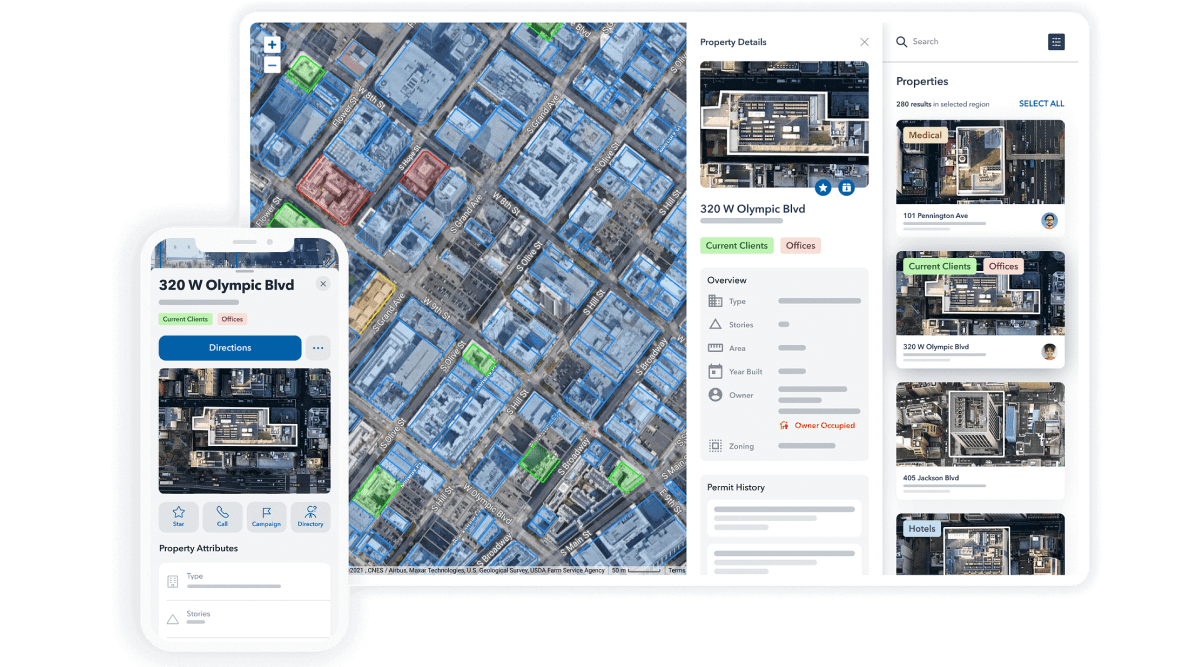Introduction
You're sitting at your desk, staring at the same list of prospects you've been calling for months. Your team's hitting their activity metrics - 150 calls a week, 30 drop-ins - but the pipeline feels stuck. Meanwhile, that competitor down the street just landed three of your target accounts. Sound familiar?
That's why your business development plan needs to evolve.
Here's the thing: the old playbook for FLS sales isn't cutting it anymore. Property managers are harder to reach, decision-making committees have grown larger, and everyone's inbox is overflowing with "just checking in" emails from vendors promising the same thing.
What if you could identify which properties just pulled permits for renovations, meaning they'll need system updates? What if your newest rep could walk into a facility and already know the ownership group manages 15 other properties in your territory, so the conversation can be more impactful on the bottom line?
That's the difference between hoping for growth and engineering it.
This guide will walk you through building a business development plan that actually moves the needle in 2025 - one that turns market intelligence into closed deals and transforms your team from order-takers into trusted advisors.
1. Building Your Business Development Plan's Vision for 2025

1.1 Clarify Your Long-Term Vision
Let's start with an uncomfortable truth: most Fire Life & Safety companies have vision statements that could belong to any service business. "To be the premier provider of fire protection services" doesn't tell your team where you're going or why it matters.
Your vision needs teeth. It should inform a business development plan that paints a picture so clear that your newest technician understands how their work connects to something bigger and more meaningful than a salary alone.
Take Pye-Barker Fire & Safety's approach. They went from five locations to over 100 nationwide, but their vision wasn't just about geographic expansion. As Nick White, their Regional Director of Sales, puts it, they focused on building "trust equity" with customers- creating relationships strong enough to weather the inevitable service hiccups that come with protecting lives and property.
Here's how to craft a vision that actually drives behavior:
Start with your differentiator: What can you uniquely deliver that others can't? Maybe it's response time, technical expertise, regulator insights, or relationship depth.
Connect it to customer outcomes: Don't talk about what you do - talk about what customers achieve because of what you do. "Managers at every building in our market sleep soundly knowing their people are protected," beats "leading fire safety provider" every time.
Make it measurable: Your vision should imply metrics - if you're talking about market coverage, showcase the amount of protected square footage you’re tracking. If it's about relationships, you're measuring customer lifetime value and retention.
1.2 Identify and Communicate Your Mission
Your mission is the "how" behind your vision. It's the daily actions that compound into long-term success.
The key shift for 2025? Your mission must embrace both consistency and adaptability. Fire codes don't change overnight, but the way buildings are managed, how decisions get made, and what property owners prioritize - that's evolving rapidly.
Consider building your mission around three pillars:
Value Creation: What specific value do you create for each stakeholder? For property managers, it might be “compliance confidence.” For building owners, it's “asset protection” and “liability reduction.”
Innovation Integration: How will you continuously improve service delivery? This isn't about chasing shiny objects - it's about systematically adopting tools and processes that make your team more effective.
Relationship Depth: In an industry built on trust, how will you systematically deepen customer relationships beyond the annual inspection?
2. Setting Business Development Plan Goals That Drive Revenue

2.1 Setting Clear Objectives
Here's where most business development plans fall apart. They set objectives like "grow revenue 20%" without connecting them to specific actions and capabilities.
Your 2025 objectives need to bridge the gap between aspiration and execution. They should tell a story about how you'll win.
For example, instead of "increase market share," try:
"Capture 40% of inspection-due properties in our core territories by combining proactive outreach with compliance expertise."
"Expand wallet share within existing accounts by 30% through systematic cross-selling or up-selling of integrated life safety solutions."
"Reduce sales cycle time by 25% by providing reps with instant access to property intelligence and decision-maker contacts."
Each objective implies specific capabilities you'll need to build, metrics you'll track, and behaviors you'll reward.
2.2 Utilizing OKRs and KPIs for Effective Goal Management
The OKR (Objectives and Key Results) framework works particularly well for Fire Life & Safety companies because it connects high-level goals to measurable outcomes.
Here's a practical example:
Objective: Become the trusted advisor for fire safety in our market
Key Results:
Achieve a 90% on-time inspection completion rate (builds trust through reliability)
Generate 50% of new business from customer referrals (indicates advisory relationship)
Increase average contract value by 35% through consultative selling (shows customers value expertise)
But here's the twist for 2025: your KPIs need to measure both efficiency and effectiveness.
Traditional KPIs (still important):
Number of calls made
Proposals submitted
Close rate
Modern KPIs (equally critical):
Time from prospect identification to first contact
Percentage of proposals based on identified compliance gaps
Customer lifetime value growth rates (LTV + cross-selling and upselling)
Revenue per rep (not just total revenue)
Pye-Barker saw this in action. They didn't just track activity—they measured outcome-based metrics. The result? A 41% increase in per-rep revenue and an 85% year-over-year (YoY) revenue increase.
3. Integrating Technology and Digital Transformation to Accelerate Business Development

3.1 Leveraging Artificial Intelligence (AI)
Let's be honest: when most Fire Life & Safety companies hear "AI," they picture funny images online, or voice dialers that sound robotic and "glitchy." But the real application for artificial intelligence in business development is far more practical and immediately valuable.
For example, tools like Convex are using Generative AI informed by property intelligence data and buying signals to send hyper-relevant outreach messages to prospective buyers. Lemlist has an AI that segments leads and automates multi-channel outreach. Hubspot and Salesforce are building entire agent systems that support your BD team - check out Agentforce if you’re unfamiliar.
AI in 2025 isn't about replacing your sales team - it's about making them "superhuman." Imagine your rep making a cold call armed with:
The property's inspection history across all systems
Recent permits pulled that indicate renovation or expansion
Contact information for actual decision-makers, not just whoever answers the phone
Ownership details that reveal 14 other properties they manage
This isn't science fiction. Pye-Barker's team experiences this daily using Atlas. As Nick White shared, he walked into a facility and asked about the owner by name - information he had at his fingertips through intelligent data systems. The facility manager was shocked. That moment of surprise became instant credibility.
3.2 Capitalizing on Digital Transformation
Digital transformation in FLS isn't about having a website or sending email quotes. It's about fundamentally changing how you identify, pursue, and serve customers.
The shift happens in three phases:
Phase 1: Digitize Your Data
Move from paper inspection reports to digital records (Hopefully already done this - it is 2025 after all!).
Create searchable databases of customer information (this can be in Convex, your CRM, or another tool that allows you to add custom data for personalization)
Build accessible libraries of compliance requirements
Phase 2: Connect Your Systems in a CRM
Link inspection data to CRM records
Connect billing to service history
Integrate prospecting tools with your CRM to create a better workflow
Phase 3: Generate Intelligence
Identify patterns in service data that predict equipment failure (like adding custom fields for warranty data or equipment service history)
Spot market opportunities through permit and property data
Predict customer needs based on compliance cycles
The transformation pays off quickly. When Pye-Barker rolled out Atlas in the fourth quarter of 2020, they saw immediate results: $254,000 in additional revenue in just three months, during a pandemic no less.
3.3 Employing Data Analytics for Better Decision-Making
Data without decisions is just expensive storage. The key for 2025 is turning information into action.
Start with these high-impact analytics:
Market Intelligence:
Which territories have the highest regulations and/or the highest concentration of non-compliant properties?
Where are competitors vulnerable due to service issues and accessibility?
Which property types can you offer the best value?
Sales Performance:
Which activities actually correlate with closed deals?
What's the optimal touch pattern for different customer types?
Where do deals stall in your pipeline?
Customer Insights:
Which customers are at risk of churning?
Who's most likely to buy additional services?
What triggers customer complaints?
The goal isn't to drown in dashboards. It's to identify the 3-5 metrics that, if improved, would transform your business, then relentlessly focus on moving those numbers.
3.4 Building Your Tech Stack for Maximum Impact with Property Intelligence Software
Here's the frustrating reality: you've probably tried sales intelligence or property intelligence tools before.
Maybe you invested in a contact database that promised "millions of verified leads" but gave you generic office numbers. Or perhaps you bought into a CRM that tracks everything except what actually matters for FLS sales, like permits, added schemas for data like when an inspection is due, so you know the property manager’s level of urgency.
The problem runs deeper. Your reps waste hours every day on dead-end activities:
Driving to properties only to find out the decision-maker works remotely or from another state
Cold calling businesses that just signed 5-year contracts with competitors
Manually researching ownership info that's outdated by the time they use it
Missing hot opportunities because they're chasing cold leads
Meanwhile, your competitors seem to appear at properties right when inspections are due, magically. They walk in knowing the property manager's name, the building's permit history, and which systems need updating. It's not magic - they just have better intelligence.
Most "property intelligence" tools weren't built for the unique challenges that FLS teams face. They don't understand that in our industry, timing is everything. A property with an inspection due in 30 days is 10x more valuable than one that just renewed. A building that just pulled renovation permits needs system updates NOW, not next quarter.
That's where purpose-built tools make the difference. Modern FLS intelligence tools like Convex combine property data with buyer intent signals, giving your team superpowers:
Instead of generic contact lists, you get:
Verified emails for actual decision-makers, not receptionists
Phone numbers for property owners, managers, and directors (at the property level) who are rarely at their desks
Ownership group details that reveal multi-property opportunities
Instead of random prospecting, you see:
Permit data showing renovations and expansions
Buyer intent data to showcase who’s actively looking for your solutions
Properties under new management (perfect time to switch vendors)
Instead of inefficient routes, you plan:
Clustered visits by geography and route efficiency
Prioritized stops based on building size, tenant makeup, and opportunity value
Optimal paths that save hours of windshield time

Each of your sales team members can now:
Log in to Convex and check the “Signals” category (our proprietary buyer intent data) to see who’s ready to buy in your market.
Then, search for any commercial property type, even multiple types, and access contact information, job titles, account names, property addresses, or tenants to identify who to contact, bringing up a list of prospects to pursue.
With just two clicks, you can use Generative AI trained on their buying signals and your own company and contact data to send them an email or draft a script for a phone call. (Pro Tip: If you want to go the extra mile, create a quick Loom video with the information you gather in Atlas. Studies show this will not only give prospects the personalized touch they are looking for but also increase your conversion rates!).
Once you’ve sent the message, set up an automated follow-up (or) reminder and add them to your pipeline in Salesforce, Hubspot, or another CRM.
With Convex, it really is that easy to prospect and make contact with potential customers, allowing you to focus on what really matters to your bottom line- selling.
4. Aligning Business Development with Marketing and Brand Strategy

4.1 Creating Synergy between Marketing and Business Development
In Fire Life & Safety, "marketing" often means slapping your logo on a truck and hoping people call when they see it. That worked in 1995. Today, your prospects are researching solutions online before they ever talk to a rep.
The companies winning in 2025 align marketing and sales around the customer journey:
Awareness Stage: Marketing creates educational content about compliance changes, safety best practices, and industry trends. Sales uses this content to provide value in early conversations.
Consideration Stage: Marketing develops case studies and comparison guides. Sales leverages these to position your company as the expert choice.
Decision Stage: Marketing provides social proof through testimonials and certifications. Sales reinforces this credibility in proposals and presentations.
The key is breaking down the wall between marketing and sales. They should share goals, swap insights weekly, and collaborate on campaign strategies.
4.2 Understanding and Engaging Customers in 2025
Your customers have changed. The property manager who used to handle everything now reports to a facilities director who reports to a regional VP. Decisions that once took days can now take months.
But they've also become more sophisticated. They want partners, not vendors. They value expertise over low prices. They'll pay more for someone who makes their job easier.
Here's how to adapt:
Map the Real Decision Process: Who's involved? What are their individual concerns? The facilities manager cares about compliance. The CFO cares about budget predictability. The operations director cares about minimal disruption. Address all three.
Provide Value Between Transactions: Share regulatory updates. Offer building safety assessments. Host training sessions for their maintenance teams. Become indispensable beyond the inspection.
Anticipate Needs: Use your data to be proactive. "Hi John, I noticed your Building B inspection is due in 60 days. I've already blocked time on our calendar. Also, with the recent code changes, you'll need to update your emergency lighting. Here's what that involves..."
5. Building Flexible and Resilient Business Operations
5.1 Embracing Adaptability and Continuous Improvement
Remember March 2020? Properties locked down. Inspections postponed. Revenue projections out the window. The companies that survived, and even thrived, were those that could adapt without abandoning their core mission.
Building adaptability into your 2025 plan means:
Flexible Service Delivery: Can you offer remote inspections for certain systems? Virtual consultations for planning? Digital documentation for compliance?
Scalable Processes: Your systems should work whether you have 5 reps or 50. Document everything. Automate what's repeatable. Preserve time for what requires human judgment.
Learning Loops: Every lost deal teaches you something. Every customer complaint reveals an opportunity. Build systematic ways to capture, analyze, and act on these lessons.
5.2 Preparing for Uncertainty and Risk Management
The next disruption probably won't be a pandemic (hopefully). It will be a data security breach, a key leader needing to step away for a time, or some other factor none of us can predict. Maybe it's new regulations, market consolidation, or technology shifts. You can't predict it, but you can prepare for it.
Financial Resilience:
Build and maintain diverse revenue streams (inspection, service, installation, monitoring) to decrease the fragility of your organization.
Build recurring revenue through service agreements and maintenance contracts.
Keep cash reserves for opportunities (like acquisitions) or emergencies.
Operational Flexibility:
Cross-train team members across functions
Develop relationships with strategic partners
Create modular service offerings that can be adjusted quickly
Market Intelligence:
Monitor regulatory changes actively through NFPA's comprehensive standards
Track competitor moves and market consolidation
Stay connected to customer sentiment and needs
5.3 Improving Operational Efficiency
Efficiency in 2025 isn't about doing more with less—it's about doing the right things exceptionally well.
Focus on three areas:
Route Optimization: Use technology to cluster drop-ins geographically. One windshield hour saved per tech per day adds up to massive capacity gains over the long-term.
Documentation Automation: Every minute spent on paperwork is a minute not spent with customers. Invest in systems that capture data once and populate it everywhere needed.
One tool that we’ve seen implemented well is Superwhisper. Superwhisper is a voice note tool that runs in the background on your devices and will automatically allow you to switch from typing to voice dictation. Click in a text box and make notes while you’re on the go!
Knowledge Management: Your senior techs have decades of experience. Capture it. Document it. Make it accessible to everyone. This is your competitive moat.
Today, knowledge management is getting easier than ever. Google Workspace is a great place to start and it integrates directly with hundreds of other tools. Trainual allows you to build SOPs and training modules from your best workers and leaders. Notion allows you to add all of your training resources into pages that can easily be linked to a training system.
The bottom line is that these tools are a few of the hundreds you could be using to accelerate your team’s technical development - but finding the right one (the one you use most effectively) will take a bit of work.
6. Executing a Business Development Plan Effectively
6.1 Ensuring Effective Implementation
A brilliant strategy with poor execution loses to an average strategy executed flawlessly. The difference? Clarity, accountability, and rhythm.
Clarity: Everyone should understand not just what to do, but why. When Pye-Barker rolled out Atlas, they didn't just hand reps a login. They showed how it would make their jobs easier and their commissions bigger.
Accountability: Set clear owners for each initiative. "Everyone's responsible" means no one's responsible. Name names. Set deadlines. Track progress publicly.
Rhythm: Establish a cadence that keeps momentum without burning people out:
Daily huddles for frontline teams (5-10 minutes max)
Weekly pipeline reviews for sales
Monthly strategic progress checks
Quarterly deep dives and course corrections
6.2 Leadership and Talent Development
Your business development plan is only as strong as the people executing it. We’ve heard less over the last 12 months about workforce shortages than during COVID, but the fact remains that commercial services are still facing nearly 70% workforce shortages. Combine that with an aging workforce and talent development isn't optional - it's survival.
Invest in Leaders at Every Level:
Frontline supervisors need coaching skills, not just technical knowledge
Sales managers must balance accountability with data and support
Senior leaders should model continuous learning to set an example for the rest of their team to follow
Create Career Paths: The best tech shouldn't have to become a manager to advance. Create technical specialist roles. Offer sales engineering positions. Show people a future.
Embrace Different Working Styles: Pye-Barker has reps ranging from 21 to 70 years old. Some are digital natives. Others prefer paper. Your systems should accommodate both while gently pulling everyone toward more efficient methods.
Organizations like the American Fire Sprinkler Association (AFSA) and National Association of Fire Equipment Distributors (NAFED) offer excellent training resources to support your team's development.
6.3 Monitoring and Adjusting the Plan
The only thing worse than no plan is a plan you never adjust. Build in systematic reviews:
Monthly Health Checks:
Are we hitting our activity metrics?
Where are deals getting stuck?
What's working that we should do more of?
Quarterly Business Reviews:
Are our assumptions still valid?
What's changed in the market?
Where do we need to pivot?
Annual Strategic Planning:
What did we learn this year?
How has our market evolved?
What capabilities do we need to build next?
Remember: adjusting the plan isn't admitting failure - it's acknowledging reality. When you put the learnings from each update to your business development plan into practice, you see incremental results - when you put them all together and get your team “on board,” they’re parabolic.
In Summary

Building a business development plan that works in 2025 isn't about predicting the future. It's about creating a system that thrives regardless of what comes next.
The Fire Life & Safety companies that will dominate their markets share common traits:
They use additive technologies like artificial intelligence to multiply human capabilities, not replace them
They measure what matters, not just what's easy to count
They build deep customer relationships based on likeability, expertise, and trust
They remain flexible while staying true to their core mission (which hopefully this article has helped you create)
The path forward is clear. Properties need protection. Regulations require compliance. Building owners demand expertise. The question is: Will your team be the one that delivers?
Start with one objective. Pick one technology to pilot. Choose one metric to improve. Build momentum through small wins that compound into transformation.
Your customers are counting on you to keep their people safe. Your team is counting on you to lead them forward. AI is changing the game- fast! The time for planning is over. The time for action is now.
Ready to see how leading Fire Life & Safety companies are transforming their sales operations? Schedule a free demo to see Convex in action.
Frequently Asked Questions
What should a business development plan include? A comprehensive business development plan includes clear vision and mission statements, measurable objectives with KPIs, technology integration strategy, marketing alignment, operational flexibility measures, and execution frameworks with accountability systems.
How often should you update your business development plan? Review your business development plan monthly for tactical adjustments, quarterly for strategic pivots, and annually for comprehensive overhauls. Fire, Life & Safety companies should align reviews with regulatory update cycles.
What's the difference between 2025 business development plans and traditional ones? Modern business development plans emphasize data-driven decision making, AI-powered market intelligence, flexible execution over rigid planning, and customer-centric approaches versus product-focused strategies.
Share





